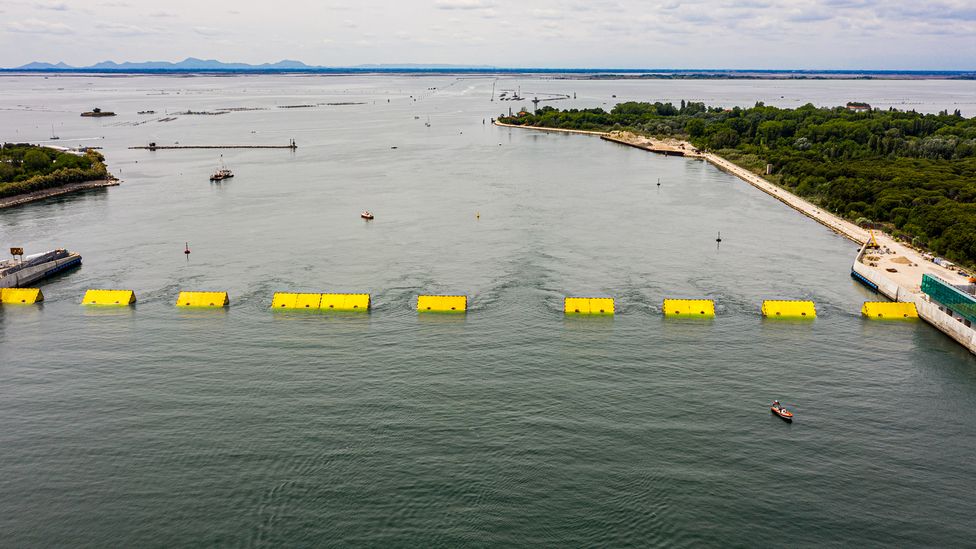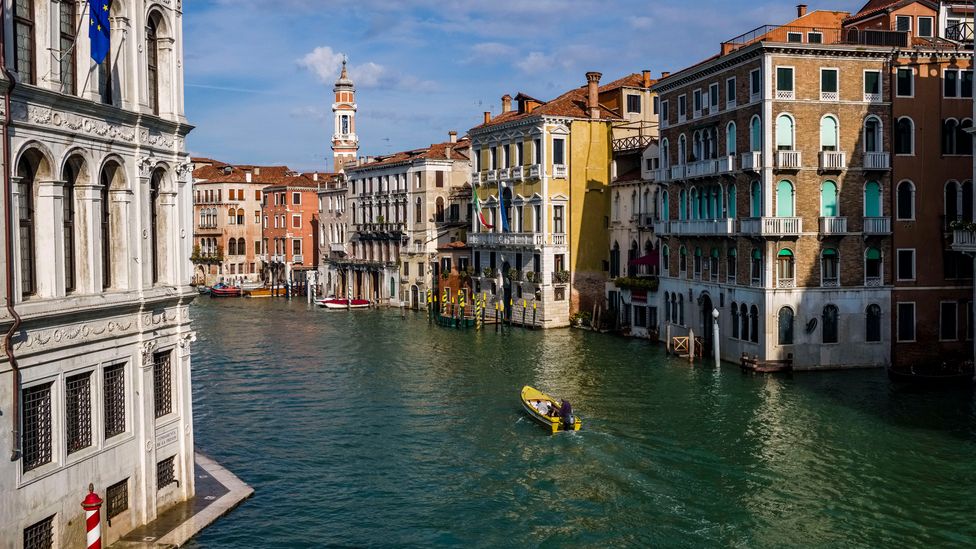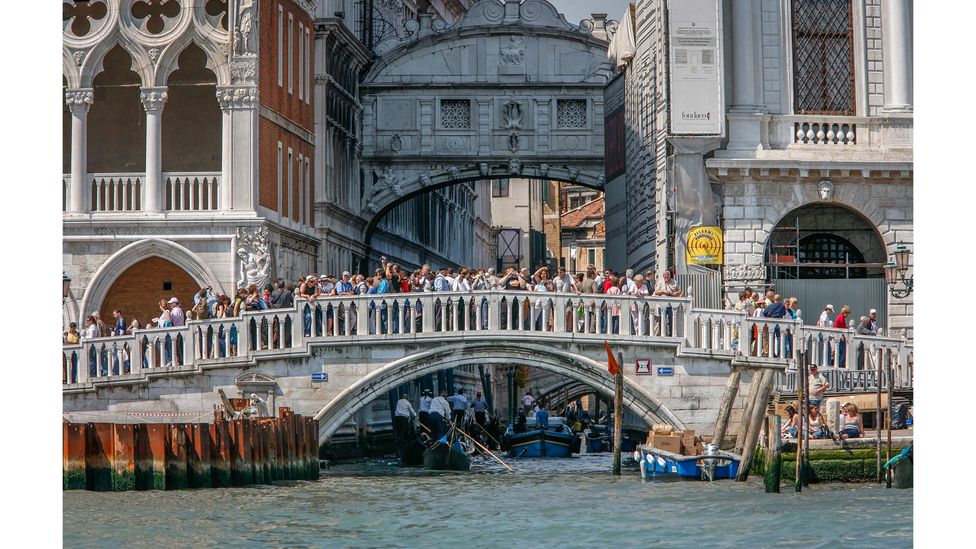Italy’s plan to save Venice from sinking
Italy #Italy

Venice is at risk of succumbing to its sinking foundations and rising sea levels. To avert disaster, the city is making changes.
V
Venice is a stunning oddity. It is a city built atop around 120 islands, crisscrossed by 177 canals, and is best explored – when on foot at least – via the use of its 391 bridges. It is a watery maze of a city, full of tiny footpaths and tucked away squares, hidden museums and secluded, centuries-old churches.
But all is not well in “La Serenissima”. Indeed, if drastic measures are not taken, the city’s days could be numbered.
This is far from hyperbole: Venice is at very real risk of being consumed by the sea. In worst-case scenario, the city could disappear beneath the waves by as early as 2100. Meanwhile, many of its building are sinking or being damaged by the wakes of boats. It is also routinely overwhelmed by tourists, while its local population is in a state of continual decline.
Around the globe, hosts of cities are being similarly hit by Venice’s core problems of subsidence and rising sea levels. Low-lying Jakarta, for example, home to around 11 million people, is in such dire straits that it is being replaced as the capital city of Indonesia by Nusantara, a city not yet even built.
Every at-risk city has its own challenges to tackle. But given Venice’s small size, fame and ability to access funding, it could be an ideal proving ground for technologies and approaches that will play a key role in the global fight against the rising sea.
From elaborate ocean barriers to wake-minimising boats, could Venice’s plight lead to tangible, practical solutions that could be deployed the world over?

A flooded St. Mark’s Square in December 2020 following an “alta acqua” event. The Mose gates were not lifted (Credit: A.Pattaro/Getty Images)
In November 2019, Venice suffered its second-worst flooding event since records began almost 100 years ago. It created headlines around the world, with onlookers stunned by the incredible images of Saint Mark’s Square, one of the city’s lowest lying and most iconic areas, covered in feet of water.
The tide reached a peak height of 187cm (6.1ft) above sea level, resulting in more than 80% of the city being under water. A state of emergency was declared, and there was an estimated €1bn euros (£0.9bn/$1bn) worth of damage, according to the Mayor of Venice, Luigi Brugnaro.
The worst ever flooding event, which happened in 1966, saw water levels rise to 194cm (6.4ft) above sea level, and is thought to have seriously damaged at least three quarters of the city’s shops, businesses and studios.
While a gap of over 50 years separated these events, recent trends suggest that we won’t have to wait half a century to see another calamitous flood. Since water levels started being officially recorded in 1923, they have reached 150cm (59in) or more on only 10 occasions, but five of those have been in the last three years.
“Climate change has caused a rise in sea levels, so any city built at sea level is particularly vulnerable,” says Sally Stone, reader in architecture and adaptive reuse at the Manchester School of Architecture.
You might also like:
Venice has always been compelled to battle against the sea, with small, manageable “acqua alta” events, where the city is flooded temporarily at various times in the year, occurring for centuries. But the recent spate of high tides is unprecedented.
And it’s set to continue. According to a 2021 report, even if global temperatures are kept below a 2C rise above pre-industrial levels, Venice’s sea level would rise by 32cm (13in) by 2100. A worst-case scenario of 4C temperature rise, linked to dramatic melting of the ice sheets, could see 180cm (5.9ft) of relative sea level rise in Venice by 2100 – similar to the level reached by the 2019 floods which caused so much damage.
“We are certain that the sea level will continue to rise over the coming decades due to the ongoing melt of the Antarctic and Greenland ice sheets, as well as mountain glaciers,” says Natasha Barlow, associate professor of quaternary environmental change at the University of Leeds in the UK.
Barlow notes that even a small increase in sea levels can cause significant increases in the frequency and intensity of coastal flooding, because the higher sea level raises the baseline water level of storms, tides and waves.

Venice’s Mose barriers are raised during a test in May 2020 (Credit: G.Cosua/Getty Images)
What’s more, Venice itself is sinking.
The foundations of Venice’s buildings are constructed using a system of piles, Stone says – long lengths of timber that are pushed vertically into the loose mud and clay of the lagoon below. The solid bedrock of the lagoon is far further below the surface than this mud, so the foundations are being pushed into a more substantial, but still slightly vulnerable, layer of compressed clay, adds Stone.
Over centuries, many of the buildings built atop this unstable foundation have shifted position and, in numerous instances, started to sink into the mud. Historical groundwater extraction has enhanced this impact, and Venice has sunk roughly 15cm (5.9in) over the past century.
No simple remedy for this slow sinking exists, and Stone says it is a difficult problem to solve. “Pumping large amount of concrete into the foundations is likely to cause much greater damage than doing nothing, as the delicate movement is a necessary part of the structural system,” she says. It would also be difficult to retrofit most of the buildings in Venice without severely compromising their aesthetic integrity, she adds.
Other actions have been mooted. “Deepening of underwater channels should help reduce flooding,” says Hayley Fowler, professor of climate change impacts at Newcastle University in the UK.
Instead, in a bid to hold back the rising water and protect the city, Venice is putting the majority of its eggs in one basket: the soon-to-be-completed Mose (Experimental Electromechanical Module) project.
This is installing sea-based defensive barriers made up of 78 mobile gates (which can admit vessels), each 20m (66ft) wide and located at strategic locations to create a “coastal cordon” which, it is hoped, will minimise major flooding events.
The barriers lie submerged during periods of calm, but rise up to block the incoming tide in the lagoon when waters rise to 110cm (3.6ft), according to Consorzio Venezia Nuova, the company building the system.
The development of Mose has been far from straightforward. It was first conceived of in 1992 and has endured delays and soaring costs ever since. Construction began in 2003, with the original aim to have work completed by 2011. In reality, Mose was only activated for the first time in 2020, and even today is not yet fully operational. It is now scheduled to be finished in late 2023.
It could end up costing around €8bn (£7bn/$8bn) against an initial budget closer to €4.7bn (£4.1bn/$4.7bn), while there is also a huge financial burden to using the barrier – Consorzio Venezia Nuova has suggested it could cost €323,000 (£280,000/$323,000) each time it is raised.

The Mose project is far from universally loved by those who want to protect Venice (Credit: G. Cosua/Getty Images)
The project is also far from a complete solution. Mose has been designed to combat large water level rises, and so won’t be able to stop the flooding of particularly low-lying areas, such as Saint Mark’s Basilica. Mose’s barriers will only be raised once water levels reach 110cm (3.6ft), but Saint Mark’s floods at around 90cm (3ft).
“A highly impacting, heavily engineered and what many consider overly complicated solution was adopted,” says Jane da Mosto, co-founder and executive director at We Are Here Venice, a nonprofit focused on understanding and addressing Venice’s various challenges. “It can, at best, only prevent extensive flooding of the city and other islands caused by extreme events. Things need to be done to protect the urban fabric from the chronic impacts of higher and higher average water levels.”
Closing the gates too frequently will also eventually “doom” the lagoon, says Fabio Carrera, a professor at Worcester Polytechnic Institute in Massachusetts and founder of Venice Project Center, a student-led initiative that explores ways to preserve and improve life in Venice. If the barrier is raised frequently, he says, sewage could become trapped in the lagoon, which would not only be unpleasant, but could destroy the ecosystem.
“Mose is going to work for a time – maybe 100 years or so – but I think that, in the end, a Dutch-style solution will have to be introduced,” says Carrera.
A Dutch-style solution would involve following the blueprints set out by the Delta Project, a huge flood management system consisting of 13 dams and a host of dikes, barriers and sluices that has been operating in the Netherlands since 1997. According to the Watersnoodmuseum – a Dutch museum dedicated to all things flooding – it is so effective that the region it protects will only be flooded once every 4,000 years.
A similar construction would, according to Carrera, be able to minimise flood risk in Venice, but it’s far from a quick fix. The Delta Project took almost 50 years to complete, cost around $7bn (£6.2bn) and is incredibly intricate. The total length of the dams is 18.5 miles (30km), making it around 18 times bigger than Mose. “Given it took 40 years to get Mose up and working, we need to start thinking far, far into the future,” says Carrera. “We need to be seeking those ultimate solutions […] right now.”
Swenja Surminski, head of adaptation research at the Grantham Research Institute on Climate Change and the Environment in London, agrees Venice’s future will be dictated by the decisions made today. “Particularly in places such as Venice, flood risk needs to be integrated into a city’s vision: how do we want our city to look like in 10, 20, 50 years?” she says.

Wave-related water damage that has affected 60% of the Venetian buildings that line the Grand Canal (Credit: F.Bienewald/Getty Images)
But rising seas and flooding are not the only problems facing Venice when it comes to water.
Water is at once Venice’s core attraction and its most significant foe. It is a city surrounded by and built upon water. This unique quality makes it an ideal location for a port, and plays a key role in attracting its millions of annual visitors.
In terms of preserving the city and its local ecology, however, this is far from favourable. Moto Ondoso, which translates directly to “swell”, is a term often used to describe the wake created by motorboats, and is partly responsible for wave-related water damage that has afflicted 60% of Venetian buildings that line the Grand Canal.
Such damage is compounding the flooding issue, making buildings and the city’s stone foundations weaker, while increasing the amount of money that needs to be allocated to maintenance works.
“Throughout its history Venice has required a lot of maintenance and preventive measures,” says Monika Schmitter, a professor at the University of Massachusetts Amherst who specialises in the material culture and built environment of Venice. “The problem arises when these measures are not taken continuously.”
Some moves have already been made to tackle the issue of damage to buildings. Since 2021 cruise ships, which Stone says created much bigger waves within the confined space of the canal, have been banned from entering the historic centre of the city, and must instead dock at the industrial port.
But more could be done. “If I could implement one change tomorrow, all the filthy, antiquated, diesel-guzzling vaporetti [water buses] and cargo barges that circulate Venice’s canals would be refitted with hybrid-electric engines,” says da Mosto.
There are already signs of a shift in this direction. Candela, a Swedish company that builds electric hydrofoil boats, has carried out initial trials in Venice’s lagoon.
Mikael Mahlberg, communications manager at Candela, says the boats fly above the water at high speeds, using 80% less energy than conventional crafts. “The hydrofoil means that our boats produce extremely small wakes of around 5cm (2in), instead of up to a metre (3.3ft) for a conventional boat of the same size,” he says.
But Carrera says that while the concept is worth exploring, it is unlikely these boats will be introduced in the very near future. “Hydrofoil boats need to be able to reach certain speeds to work, and it might not be possible to achieve these in Venice, but we’ll see,” he says.
Schmitter says it would be better to simply ban motorboats. “But I don’t think it will happen,” she adds.
Compelling all boats to cut their speeds is therefore another way to reduce water damage. Venice’s gondoliers have previously staged protests to try and get the city’s water speed limits reduced – boats are currently allowed to travel at a maximum of 11 km/hr (7 mph) to prevent wake damage, which some consider still to be too high, but others flout the limit altogether.

During peak days in the summer in Venice, tourists can outnumber locals by a ratio of 2:1 (Credit: Andia/Getty Images)
The city desperately needs local solutions to these problems. But some argue giving local people the breathing room and finances to develop these solutions is a difficult feat in a city routinely flooded with tourists.
Around 5.5 million tourists visited Venice in 2019, 100 times Venice’s population of 55,000. A similar number of tourists headed to Madrid and Moscow, two cities far larger in geographical size, with populations of 6.7 million and 12.6 million respectively. During peak days in the summer in Venice, tourists can outnumber locals by a ratio of 2:1.
Da Mosto pinpoints three main problems with tourism in Venice: an overreliance of the economy on it; the extensive damage it causes to local infrastructure; and the fact it leads to “brain drain”.
Tourism is ideal for the hospitality sector, but not quite so beneficial for other industries, says Carrera. Brain drain, a term that refers to educated people moving away from a particular location, is a serious problem in Venice – for people with career interests outside of tourism, there are often more and better opportunities to be found elsewhere.
Carrera argues this is hastening Venice’s decline, by drawing away the very people needed to solve its issues. “Every city and country has its own hurdles to overcome, and this requires bespoke solutions created by the people who know those areas intimately,” he says.
Venice Lagoon Plastic Free is one example of Venetians coming together to improve the city. The local non-profit carries out water sampling and analysis of the canals and the lagoon to build awareness of pollutant levels in the water. It runs tourist-facing initiatives – such as creating a map of public drinking foundations to minimise plastic waste – and cleaning activities in a bid to increase water quality and create recognition of Venice’s fragile ecology.
Such projects showcase that those with a personal connection to Venice are crucial to its protection. Indeed, if Mose does, as predicted by Carrera, end up seriously damaging the health of the lagoon, these groups will be vital to finding appropriate, workable solutions.
Carbon Count
The emissions from travel it took to report this story were 0kg CO2. The digital emissions from this story are an estimated 1.2g to 3.6g CO2 per page view. Find out more about how we calculated this figure here.
Partly in response to public outcry and protests regarding the city’s depopulation, Venice has plans to introduce a €5 (£4.30/$5) fee for day visitors from 2023 to discourage one-day tourism.
But other tangible changes will need to be taken to return Venice to a city where people want to live, and which can provide for future generations.
Carrera says the city should aim to become a haven for such start-ups, especially those with an environmental focus. “We have the perfect conditions here for anyone interested in developing technologies related to coastal or water management. And this, I think, could be the key to solving Venice’s problems in the long-term. The problems in Venice will be best solved in Venice.”
Despite the challenges facing Venice, da Mosto says she is hopeful about the city’s chances of survival. “Venice is an amazing city and an inspiration,” she says.
In the end, Venice’s very position as such an admired and sought after city may be the key to making these protective changes happen here first. “I don’t think the world will let Venice disappear,” says Carrera.
—
Join one million Future fans by liking us on Facebook, or follow us on Twitter or Instagram.
If you liked this story, sign up for the weekly bbc.com features newsletter, called “The Essential List” – a handpicked selection of stories from BBC Future, Culture, Worklife, Travel and Reel delivered to your inbox every Friday.